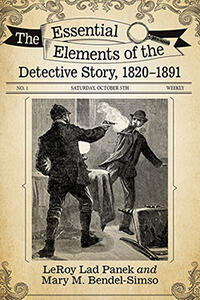English professors’ new book examines early detective fiction
After unraveling the mystery of the void in 19th century detective stories and following a decade-long trail collecting and compiling the forgotten whodunits, professors LeRoy Panek and Mary Bendel-Simso authored a new book exploring early detective fiction. “Essentials Elements of the Detective Story, 1820-1891” examines detective fiction during its formative years, while focusing on such crucial elements of the stories as setting, lawyers and the law, physicians and forensics, women as victims and heroes, crime and criminals, and police and detectives.

After unraveling the mystery of the void in 19th century detective stories and following a decade-long trail collecting and compiling the forgotten whodunits, professors LeRoy Panek and Mary Bendel-Simso authored a new book exploring early detective fiction.
“Essentials Elements of the Detective Story, 1820-1891” examines detective fiction during its formative years, while focusing on such crucial elements of the stories as setting, lawyers and the law, physicians and forensics, women as victims and heroes, crime and criminals, and police and detectives.

The book is the result of a decade of super sleuthing by the authors and the compilation of their vast collection of 19th century crime fiction into an online resource they created, the Westminster Detective Library. It’s the second collaboration for Panek and Bendel-Simso — the first is “Early American Detective Stories, An Anthology.”
Theirs is really a classic detective story. The two academic scholars followed one clue after another to solve the mystery of why there was a void in crime fiction before and between 1842 and 1891 — before and between Edgar Allen Poe’s “The Murders in the Rue Morgue” and Sir Arthur Conan Doyle’s syndicated Sherlock Holmes series.
The clues — occasional stories that popped up in other searches — led the professors down a trail literally paved with hundreds of long lost whodunits published not in books but in the thousands of newspapers and magazines scattered across the U.S. in the 1800s.
Hoping to preserve this early detective fiction, Panek and Bendel-Simso compiled the digital Westminster Detective Library, a one-of-a-kind collection of more than 1,300 detective stories published in newspapers and magazines from 1800-1891. Over the years, several dozen student researchers have assisted with scanning, transcribing and editing the short stories included in the early crime fiction online collection.
“These stories have value in what they reveal about the people and their times,” says Bendel-Simso, professor of English. “Order is restored, good triumphs over evil — there’s historical context. We found 85 stories about counterfeiting from the 1850s. What does that tell you?”
Panek was first to tap into the crime fiction genre for a course at the College. It was in 1979 or so, and he was searching his brain for a Jan Term course, something uncommon that would pique his students’ curiosity and give them something new and different to explore. He considered focusing on popular fiction and that led him to detective stories.
“I had never read a detective story before that,” says Panek. “I discovered that there was virtually no criticism about the topic. Crime fiction was an intellectual plaything of American academics — certainly not scholarly pursuit.”
In the next 20 years, Panek wrote a few pieces on Edgar Allan Poe, considered the father of detective fiction, but mostly turned to 20th century crime fiction. By 2006 he had authored seven books on police and detective novels and one on spy novels. None of the books focused on detective stories in the 1800s, but Panek’s research had begun to turn up crime fiction written during this period and published in newspapers and magazines.
“I started collecting 19th century crime fiction from hits I was getting when I searched different aspects of detective stories, such as women detectives, for books I was working on,” Panek says. “It was like discovering a gold mine — apparently there was incredible interest in crime fiction in the 1800s, and I began to see researching it as an opportunity to do something that would be useful to people.”
There, on simulated aged “wallpaper” and free to amateur detectives and crime fiction fans alike, are stories dating back to 1824. So far, the earliest is “The Blasted Tree,” published in the London magazine, The Mirror of Literature, Amusement and Instruction. The shortest might well be the 239-word “A Detective’s Ruse” published in the Chester (Pa.) Daily Times on Aug. 8, 1880 and repeated under different titles in newspapers over the next year in Indiana, Wisconsin, Iowa and Manitoba, Canada. Lax copyright laws opened the doors to widespread pirating of stories, and it was not unusual to find the same or similar story published in many different publications.
Most by far are anonymous, but some familiar names appear as authors: Mark Twain, Walter Whitman before he was the poet Walt Whitman and Abraham Lincoln on “The Trailor Murder Mystery” published in 1846 in the Quincy Whig. Charles Dickens published “Hunted Down” in The New York Ledger in 1859.
Anyone can explore the Westminster Detective Library and spend an hour or a week reading the centuries old detective tales.
“Essential Elements of the Detective Story, 1820-1891” and “Early American Detective Stories, An Anthology” are available through McFarland Publishers as well as booksellers such as Barnes and Noble and Amazon.
The Academic Minute / Inside Higher Ed »
English professors Mary Bendel-Simso and LeRoy Panek with Westminster Detective Library student researchers (l. to r.) Hannah Krauss, Maggy Self, Camden Ostrander, Tyler Van Dyke, Mable Buchanan and Briana Sutton.